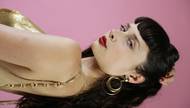In CityCenter’s 25,000-square-foot uniform distribution center on Industrial Avenue, Jhane Barnes, a slight woman with squarish glasses and short hair, proudly shows off clothing racks heavy with new uniforms.
Barnes is a New York fashion designer who was tapped by MGM Mirage to design about half of the uniforms that CityCenter employees will wear. She’s the first woman to win the Coty American Fashion Critics’ Award, and her men’s fashions are sold in boutiques and department stores such as Saks Fifth Avenue and Neiman Marcus.
Barnes’ designs for CityCenter’s 8,900 uniformed workers don’t much look like uniforms at all. She favors subtle geometric shapes digitally printed on high-quality cotton, lightweight wool in browns and slate blues and tightly woven shirts with decorative, barely there shapes and swirls.
Achieving that look is why CityCenter bosses chose Barnes, an iconoclast among fashion designers who stands out in part because she creates her own fabrics from scratch.
“I wasn’t supposed to design [traditional] uniforms,” she said. “But I didn’t want it to be like you walk in a place and you’re not sure who’s supposed to wait on you ... I sort of designed in between.”
Barnes’ task seemed straightforward enough. She has created furniture and carpet for several of the architects and designers who created CityCenter. This time, she would design clothes to go with the interiors, based on swatches of carpet and artists’ sketches.
Barnes found inspiration in the Star Wars films, which feature costumes with an outdoorsy, modern look. The eco-chic seemed to fit the vibe that CityCenter, which has received awards for environmentally friendly technology and design, was aiming for.
Instead of creating clothes in the standard range of retail sizes, she would need to craft smaller batches of clothes in more than a dozen sizes, from extra small to 6XL.
“I had to convince all my suppliers, the mills and sewing factories, to make small quantities with a lot of sizes,” she said. “If I didn’t already have a fashion line with them they probably wouldn’t have done it.”
Like typical uniforms, they would be stress-tested. But they also had to fit just right and be comfortable for regular folk who might gain or lose a few pounds during their tenure. To that end, Barnes hid elastic in some of the clothes and on some women’s jackets, used decorative bungee cords and adjustable straps.
CityCenter would pre-order sizes based on guesswork and previous resort openings. Accustomed to seeing her clothes draped on lanky, pencil-thin models, Barnes would sigh as a jacket bunched over an employee’s ample hip or belly. And yet, a perfected silhouette was possible: Behind the wall where employees try on uniforms in front of long mirrors, a half-dozen sewing machines hum in unison, tailoring pants and jackets for employees who were hired for their skills rather than the shape of their bodies.
Barnes pitched some 400 designs to CityCenter executives, of which 176 were selected to outfit 31 departments with some of the most visible jobs in the resort.
Cocktail-server uniforms—a high-profile costume designed to show off the female form to best effect—were assigned to another designer.
Designing sexy outfits for young women, said Barnes, is a specialty unto itself.







Previous Discussion: